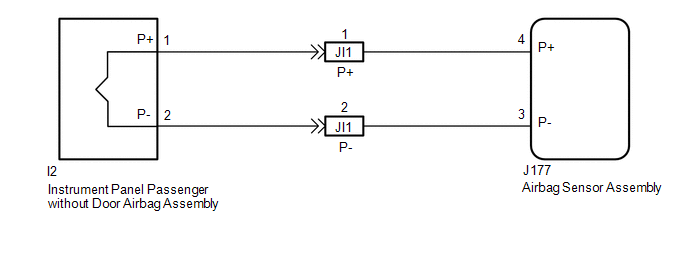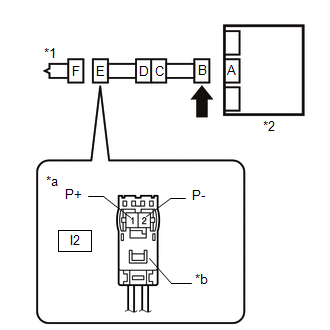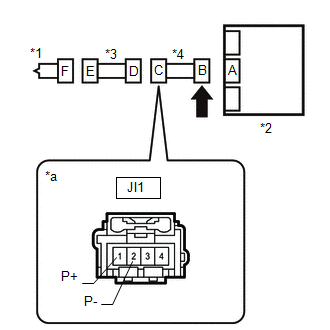DESCRIPTION The front passenger side squib circuit consists of the airbag sensor assembly and instrument panel passenger without door airbag assembly. The circuit instructs the SRS to deploy when deployment conditions are met. These DTCs are stored when a malfunction is detected in the front passenger side squib circuit.
WIRING DIAGRAM 
CAUTION / NOTICE / HINT NOTICE:
HINT: To perform the simulation method, enter check mode (signal check) with the Techstream
(Click here PROCEDURE
(b) Disconnect the cable from the negative (-) battery terminal, and wait for at least 90 seconds. (c) Check that the connectors are properly connected to the instrument panel passenger without door airbag assembly and airbag sensor assembly. Also check that the connectors that link the instrument panel wire and No. 2 instrument panel wire are properly connected. OK: The connectors are properly connected. HINT: If the connectors are not properly connected, reconnect the connectors and proceed to the next inspection. (d) Disconnect the connectors from the instrument panel passenger without door airbag assembly and airbag sensor assembly. Also disconnect the instrument panel wire from the No. 2 instrument panel wire. (e) Check that the terminals of the connectors are not deformed or damaged. OK: The terminals are not deformed or damaged. (f) Check that the No. 2 instrument panel wire connector (on the instrument panel passenger without door airbag assembly side) is not loose, deformed or damaged. OK: The connector locking button is not disengaged, and the claw of the lock is not deformed or damaged. (g) Check that the short springs of the activation prevention mechanisms of the instrument panel wire connector and No. 2 instrument panel wire connector are not deformed or damaged. OK: The short springs are not deformed or damaged.
(b) Connect the white wire side of SST (resistance: 2.1 Ω) to connector E (orange connector). CAUTION: Never connect the tester to the instrument panel passenger without door airbag assembly for measurement, as this may lead to a serious injury due to airbag deployment. NOTICE:
SST: 09843-18061 (c) Connect the cable to the negative (-) battery terminal, and wait for at least 2 seconds. (d) Turn the ignition switch to ON, and wait for at least 60 seconds. (e) Clear the DTCs. Click here (f) Turn the ignition switch off. (g) Turn the ignition switch to ON, and wait for at least 60 seconds. (h) Check for DTCs. Click here
HINT: Codes other than DTC B1805, B1806, B1807 and B1808 may be output at this time, but they are not related to this check. (i) Turn the ignition switch off. (j) Disconnect the cable from the negative (-) battery terminal, and wait for at least 90 seconds. (k) Disconnect SST from connector E.
(a) Disconnect the instrument panel wire from the airbag sensor assembly. 
(b) Check for a short to B+ in the circuit. (1) Connect the cable to the negative (-) battery terminal, and wait for at least 2 seconds. (2) Turn the ignition switch to ON. (3) Measure the voltage according to the value(s) in the table below. Standard Voltage:
(4) Turn the ignition switch off. (5) Disconnect the cable from the negative (-) battery terminal, and wait for at least 90 seconds. (c) Check for an open in the circuit. (1) Measure the resistance according to the value(s) in the table below. Standard Resistance:
(d) Check for a short to ground in the circuit. (1) Measure the resistance according to the value(s) in the table below. Standard Resistance:
(e) Check for a short in the circuit. (1) Release the activation prevention mechanism built into connector B. Click here (2) Measure the resistance according to the value(s) in the table below. Standard Resistance:
(3) Restore the released activation prevention mechanism of connector B to the original condition.
(b) Connect the cable to the negative (-) battery terminal, and wait for at least 2 seconds. (c) Turn the ignition switch to ON, and wait for at least 60 seconds. (d) Clear the DTCs. Click here (e) Turn the ignition switch off. (f) Turn the ignition switch to ON, and wait for at least 60 seconds. (g) Check for DTCs. Click here
HINT: Codes other than DTC B1805, B1806, B1807 and B1808 may be output at this time, but they are not related to this check.
(a) Disconnect the No. 2 instrument panel wire from the instrument panel wire. 
(b) Check for a short to B+ in the circuit. (1) Connect the cable to the negative (-) battery terminal, and wait for at least 2 seconds. (2) Turn the ignition switch to ON. (3) Measure the voltage according to the value(s) in the table below. Standard Voltage:
(4) Turn the ignition switch off. (5) Disconnect the cable from the negative (-) battery terminal, and wait for at least 90 seconds. (c) Check for an open in the circuit. (1) Measure the resistance according to the value(s) in the table below. Standard Resistance:
(d) Check for a short to ground in the circuit. (1) Measure the resistance according to the value(s) in the table below. Standard Resistance:
(e) Check for a short in the circuit. (1) Release the activation prevention mechanism built into connector B. Click here (2) Measure the resistance according to the value(s) in the table below. Standard Resistance:
(3) Restore the released activation prevention mechanism of connector B to the original condition.
|
Toyota Tundra Service Manual > Front Seat Outer Belt Assembly(for Crewmax): Disposal
DISPOSAL CAUTION / NOTICE / HINT CAUTION: Before performing pre-disposal deployment of any SRS component, review and closely follow all applicable environmental and hazardous material regulations. Pre-disposal deployment may be considered hazardous material treatment. PROCEDURE 1. PRECAUTION CAUTION ...